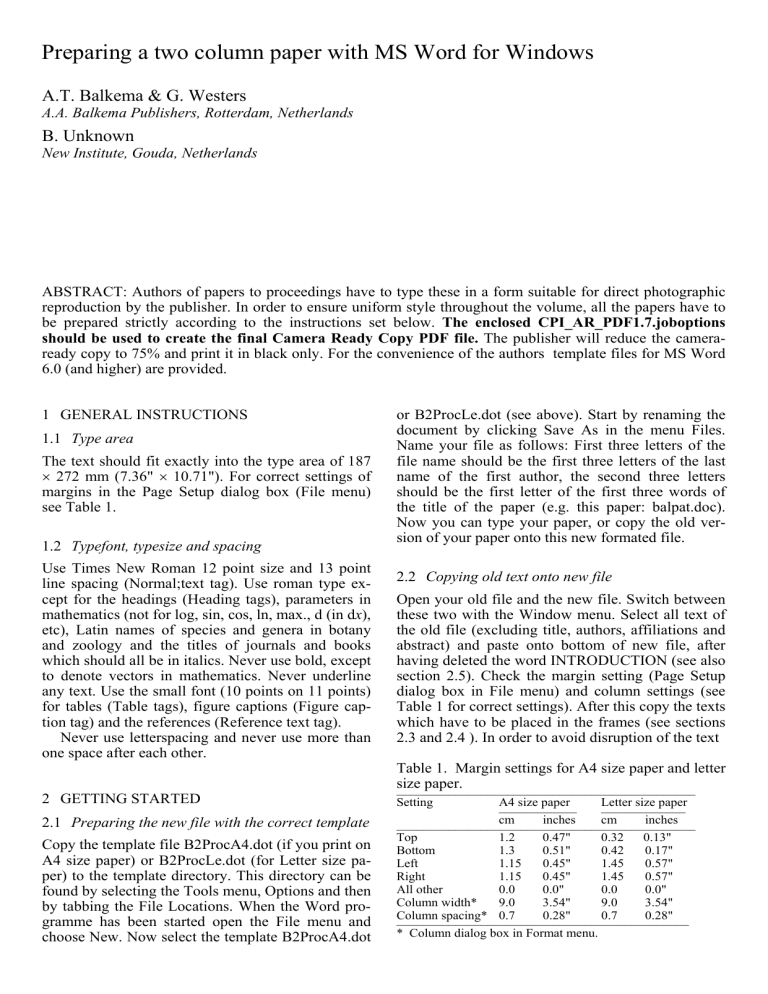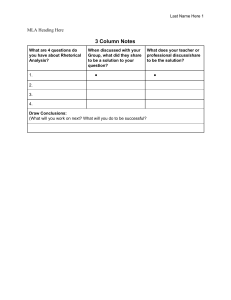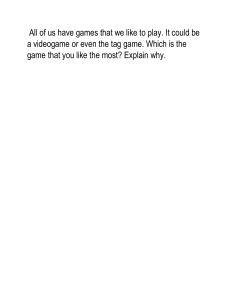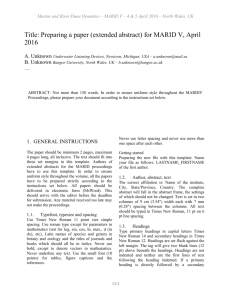
Preparing a two column paper with MS Word for Windows A.T. Balkema & G. Westers A.A. Balkema Publishers, Rotterdam, Netherlands B. Unknown New Institute, Gouda, Netherlands ABSTRACT: Authors of papers to proceedings have to type these in a form suitable for direct photographic reproduction by the publisher. In order to ensure uniform style throughout the volume, all the papers have to be prepared strictly according to the instructions set below. The enclosed CPI_AR_PDF1.7.joboptions should be used to create the final Camera Ready Copy PDF file. The publisher will reduce the cameraready copy to 75% and print it in black only. For the convenience of the authors template files for MS Word 6.0 (and higher) are provided. 1 GENERAL INSTRUCTIONS 1.1 Type area The text should fit exactly into the type area of 187 272 mm (7.36" 10.71"). For correct settings of margins in the Page Setup dialog box (File menu) see Table 1. 1.2 Typefont, typesize and spacing Use Times New Roman 12 point size and 13 point line spacing (Normal;text tag). Use roman type except for the headings (Heading tags), parameters in mathematics (not for log, sin, cos, ln, max., d (in dx), etc), Latin names of species and genera in botany and zoology and the titles of journals and books which should all be in italics. Never use bold, except to denote vectors in mathematics. Never underline any text. Use the small font (10 points on 11 points) for tables (Table tags), figure captions (Figure caption tag) and the references (Reference text tag). Never use letterspacing and never use more than one space after each other. 2 GETTING STARTED 2.1 Preparing the new file with the correct template Copy the template file B2ProcA4.dot (if you print on A4 size paper) or B2ProcLe.dot (for Letter size paper) to the template directory. This directory can be found by selecting the Tools menu, Options and then by tabbing the File Locations. When the Word programme has been started open the File menu and choose New. Now select the template B2ProcA4.dot or B2ProcLe.dot (see above). Start by renaming the document by clicking Save As in the menu Files. Name your file as follows: First three letters of the file name should be the first three letters of the last name of the first author, the second three letters should be the first letter of the first three words of the title of the paper (e.g. this paper: balpat.doc). Now you can type your paper, or copy the old version of your paper onto this new formated file. 2.2 Copying old text onto new file Open your old file and the new file. Switch between these two with the Window menu. Select all text of the old file (excluding title, authors, affiliations and abstract) and paste onto bottom of new file, after having deleted the word INTRODUCTION (see also section 2.5). Check the margin setting (Page Setup dialog box in File menu) and column settings (see Table 1 for correct settings). After this copy the texts which have to be placed in the frames (see sections 2.3 and 2.4 ). In order to avoid disruption of the text Table 1. Margin settings for A4 size paper and letter size paper. ______________________________________________ Setting A4 size paper Letter size paper ____________ _____________ cm inches cm inches ______________________________________________ Top 1.2 0.47" 0.32 0.13" Bottom 1.3 0.51" 0.42 0.17" Left 1.15 0.45" 1.45 0.57" Right 1.15 0.45" 1.45 0.57" All other 0.0 0.0" 0.0 0.0" Column width* 9.0 3.54" 9.0 3.54" Column spacing* 0.7 0.28" 0.7 0.28" _____________________________________________ * Column dialog box in Format menu. and frames, copy these texts paragraph by paragraph without including the first word (which includes the old tag). It is best to first retype the first words manually and then to paste the correct text behind. When the new file contains all the text, the old tags in the text should be replaced by the new Balkema tags (see section 3). Before doing this apply automatic formatting (AutoFormat in Format menu). 2.3 Title, author and affiliation frame Place the cursor on the T of Title at the top of your newly named file and type the title of the paper in lower case (no caps except for proper names). The title should not be longer than 75 characters). Delete the word Title (do not delete the paragraph end). Place the cursor on the A of A.B.Author(s) and type the name of the first author (first the initials and then the last name). If any of the co-authors have the same affiliation as the first author, add his name after an & (or a comma if more names follow). Delete the words A.B. Author etc. and place the cursor on the A of Affiliation. Type the correct affiliation (Name of the institute, City, State/Province, Country). Now delete the word Affiliation. If there are authors linked to other institutes, place the cursor at the end of the affiliation line just typed and give a return. Now type the name(s) of the author(s) and after a return the affiliation. Repeat this procedure until all affiliations have been typed. All these texts fit in a frame which should not be changed (Width: Exactly 187 mm (7.36"); Height: Exactly 73 mm (2.87") from top margin; Lock anchor). 2.4 Abstract frame If there are no further authors place the cursor one space behind the word ABSTRACT: and type your abstract of not more than 150 words. The top of the first line of the abstract will be 73 mm (2.87") from the top of the type area. The complete abstract will fall in the abstract frame, the settings of which should also not be changed (Width: Exactly 187 mm (7.36"); Height: Automatic; Vertical 73 mm (2.87") from margin; Lock anchor). change the tag to First paragraph and type your text after deleting the word INTRODUCTION. 3 LAYOUT OF TEXT 3.1 Text and indenting Text is set in two columns of 9 cm (3.54") width each with 7 mm (0.28") spacing between the columns. All text should be typed in Times New Roman, 12 pt on 13 pt line spacing except for the paper title (18 pt on 20 pt), author(s) (14 pt on 16 pt), and the small text in tables, captions and references (10 pt on 11 pt). All line spacing is exact. Never add any space between lines or paragraphs. When a column has blank lines at the bottom of the page, add space above and below headings (see opposite column). First lines of paragraphs are indented 5 mm (0.2") except for paragraphs after a heading or a blank line (First paragraph tag). 3.2 Headings Type primary headings in capital letters roman (Heading 1 tag) and secondary and tertiary headings in lower case italics (Headings 2 and 3 tags). Headings are set flush against the left margin. The tag will give two blank lines (26 pt) above and one (13 pt) beneath the primary headings, 1½ blank lines (20 pt) above and a ½ blank line (6 pt) beneath the secondary headings and one blank line (13 pt) above the tertiary headings. Headings are not indented and neither are the first lines of text following the heading indented. If a primary heading is directly followed by a secondary heading, only a ½ blank line should be set between the two headings. In the Word programme this has to be done manually as follows: Place the cursor on the primary heading, select Paragraph in the Format menu, and change the setting for spacing after, from 13 pt to 0 pt. In the same way the setting in the secondary heading for spacing before should be changed from 20 pt to 7 pt. 3.3 Listing and numbering When listing facts use either the style tag List signs or the style tag List numbers. 3.4 Equations 2.5 First line of text or heading If your text starts with a heading, place the cursor on the I of INTRODUCTION and type the correct text for the heading. Now delete the word INTRODUCTION and start with the text after a return. This text should have the tag First paragraph. If your text starts without a heading you should place the cursor on the I of INTRODUCTION, Use the equation editor of the selected word processing programme. Equations are not indented (Formula tag). Number equations consecutively and place the number with the tab key at the end of the line, between parantheses. Refer to equations by these numbers. See for example Equation 1 below: From the above we note that sin = (x + y)z or: Kt 1 ca tan R2 3.7.1 Typography for references 4 k1 (1) where ca = interface adhesion; = friction angle at interface; and k1 = shear stiffness number. For simple equations in the text always use superscript and subscript (select Font in the Format menu). Do not use the equation editor between text on same line. The inline equations (equations within a sentence) in the text will automatically be converted to the AMS notation standard. 3.5 Tables Locate tables close to the first reference to them in the text and number them consecutively. Avoid abbreviations in column headings. Indicate units in the line immediately below the heading. Explanations should be given at the foot of the table, not within the table itself. Use only horizontal rules: One above and one below the column headings and one at the foot of the table (Table rule tag: Use the Shift-minus key to actually type the rule exactly where you want it). For simple tables use the tab key and not the table option. Type all text in tables in small type: 10 on 11 points (Table text tag). Align all headings to the left of their column and start these headings with an initial capital. Type the caption above the table to the same width as the table (Table caption tag). See for example Table 1. 3.6 Figure captions Always use the Figure caption style tag (10 points size on 11 points line space). Place the caption underneath the figure (see Section 5). Type as follows: ‘Figure 1. Caption.’ Leave about two lines of space between the figure caption and the text of the paper. 3.7 References In the text, place the authors’ last names (without initials) and the date of publication in parentheses (see examples in Section 5). At the end of the paper, list all references in alphabetical order underneath the heading REFERENCES (Reference heading tag). The references should be typed in small text (10 pt on 11 pt) and second and further lines should be indented 5.0 mm (0.2") (Reference text tag). If several works by the same author are cited, entries should be chronological: Larch, A.A. 1996a. Development ... Larch, A.A. 1996b. Facilities ... Larch, A.A. 1997. Computer ... Larch, A.A. & Jensen, M.C. 1996. Effects of ... Larch, A.A. & Smith, B.P. 1993. Alpine ... Last name, First name or Initials (ed.) year. Book title. City: Publisher. Last name, First name or Initials year. Title of article. Title of Journal (series number if necessary) volume number (issue number if necessary): page numbers. 3.7.2 Examples Grove, A.T. 1980. Geomorphic evolution of the Sahara and the Nile. In M.A.J. Williams & H. Faure (eds), The Sahara and the Nile: 21-35. Rotterdam: Balkema. Jappelli, R. & Marconi, N. 1997. Recommendations and prejudices in the realm of foundation engineering in Italy: A historical review. In Carlo Viggiani (ed.), Geotechnical engineering for the preservation of monuments and historical sites; Proc. intern. symp., Napoli, 3-4 October 1996. Rotterdam: Balkema. Johnson, H.L. 1965. Artistic development in autistic children. Child Development 65(1): 13-16. Polhill, R.M. 1982. Crotalaria in Africa and Madagascar. Rotterdam: Balkema. 3.7.3 Endnote We would appreciate it if you make use of the enclosed Endnotes stylefile (Harvard.ens). 3.8 Notes These should be avoided. Insert the information in the text. In tables the following reference marks should be used: *, **, etc. and the actual footnotes set directly underneath the table. 3.9 Conclusions Conclusions should state concisely the most important propositions of the paper as well as the author’s views of the practical implications of the results. 4 PHOTOGRAPHS AND FIGURES Number figures consecutively in the order in which reference is made to them in the text, making no distinction between diagrams and photographs. Figures should fit within the column width of 90 mm (3.54") or within the type area width of 187 mm (7.36"). Figures, photographs, etc. can be in black/white or full color, but will be produced in the book in black/white only. Please insert the high resolution figures (see artwork document) in the word file. Figures, etc. should not be centered, but placed against the left margin. Leave about two lines of space between the actual text and figure (including caption). Never place any text next to a figure. Leave this space blank. The most convenient place for placing figures is at the top or bottom of the page. Avoid placing text between figures as readers might not notice the text. Keep in mind that everything will be reduced to 75%. Therefore, 9 point should be the minimum size of the lettering. Lines should prefera- bly be 0.2 mm (0.1") thick. Keep figures as simple as possible. Avoid excessive notes and designations. anelastic strain crack closure stiffness decrease under compression cracking f stiffness decrease in tension crack closure compressive yielding point Figure 1. Caption of a typical figure. Photographs will be scanned by the printer. Always supply original photographs. Photographs should be with good contrast and preferably in TIFF or EPS format (see Artwork document). Photographic reproductions cut from books or journals, photocopies of photographs and screened photographs are unacceptable. The proceedings will be printed in black only. For this reason avoid the use of colour in figures and photographs. Colour is also nearly always unnecessary for scientific work. 5 PREFERENCES, SYMBOLS AND UNITS Consistency of style is very important. Note the spacing, punctuation and caps in all the examples below. References in the text: Figure 1, Figures 2-4, 6, 8a, b (not abbreviated) References between parentheses: (Fig. 1), (Figs 2-4, 6, 8a, b) (abbreviated) USA / UK / The Netherlands instead of U.S.A. / U.K. / Netherlands / the Netherlands Author & Author (1989) instead of Author and Author (1989) (Author 1989a, b, Author & Author 1987) instead of (Author, 1989a,b; Author and Author, 1987) (Author et al. 1989) instead of (Author, Author & Author 1989) Use the following style: (Author, in press); (Author, in prep.); (Author, unpubl.); (Author, pers. comm.) Always use the official SI notations: kg / m / kJ / mm instead of kg. (Kg) / m. / kJ. (KJ) / mm.; 20°1632SW instead of 20° 16 32 SW 0.50 instead of 0,50 (used in French text); 9000 instead of 9,000 but if more than 10,000: 10,000 instead of 10000 14C instead of C14 / C-14 and BP / BC / AD instead of B.P. / B.C. / A.D. × 20 instead of 20 / X20 / x 20; 4 + 5 > 7 instead of 4+5>7 but –8 / +8 instead of – 8 / + 8 e.g. / i.e. instead of e.g., / i.e., 6 SUBMISSION OF MATERIAL TO THE EDITOR The camera-ready copy PDF file of the complete paper should be created with the enclosed CPI_AR_PDF1.7.joboptions file and sent to the editor. Together with the MsWord or LaTeX file. All figures should be included as high resolution file in the PDF and word file (see artwork document). Check whether the paper looks the same as this sample: Title at top of first page in 18 points, authors in 14 points and all other text in 12 points on 13 points line space, except for the small text (10 point on 11 point line space) used in tables, captions and references. Also check if the type width is 187 mm (7.36"), the column width 90 mm (3.54"), the page length is 272 mm (10.71") and that the space above the Abstact is exactly as in the sample. Write your name and the shortened title of the paper in pencil in the bottom margin of each page and number the pages correctly. 7 DEADLINE The above material should be with the editor before the deadline for submission. Any material received too late will not be published.



